Where is Corporate Training headed in 2025?
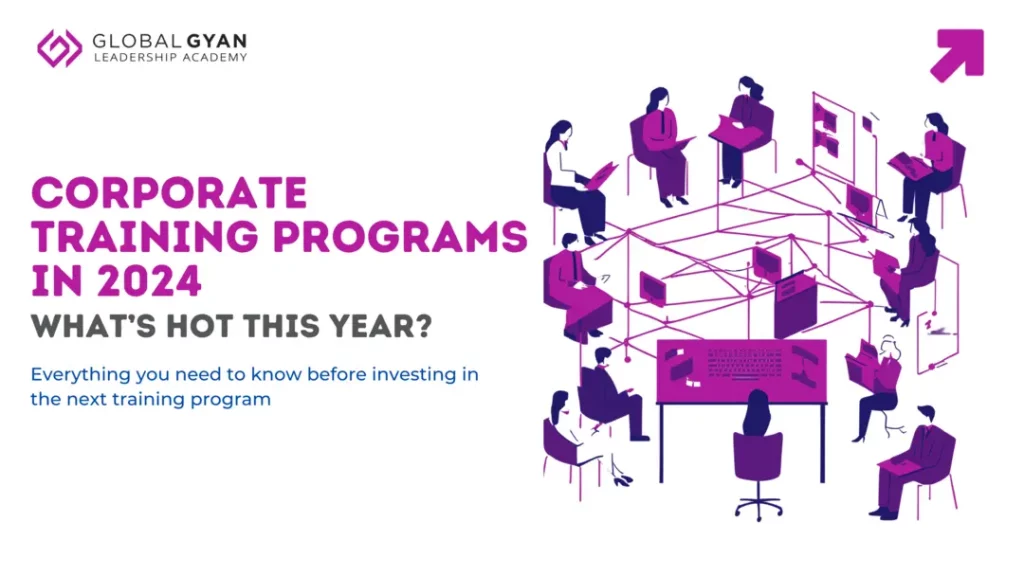
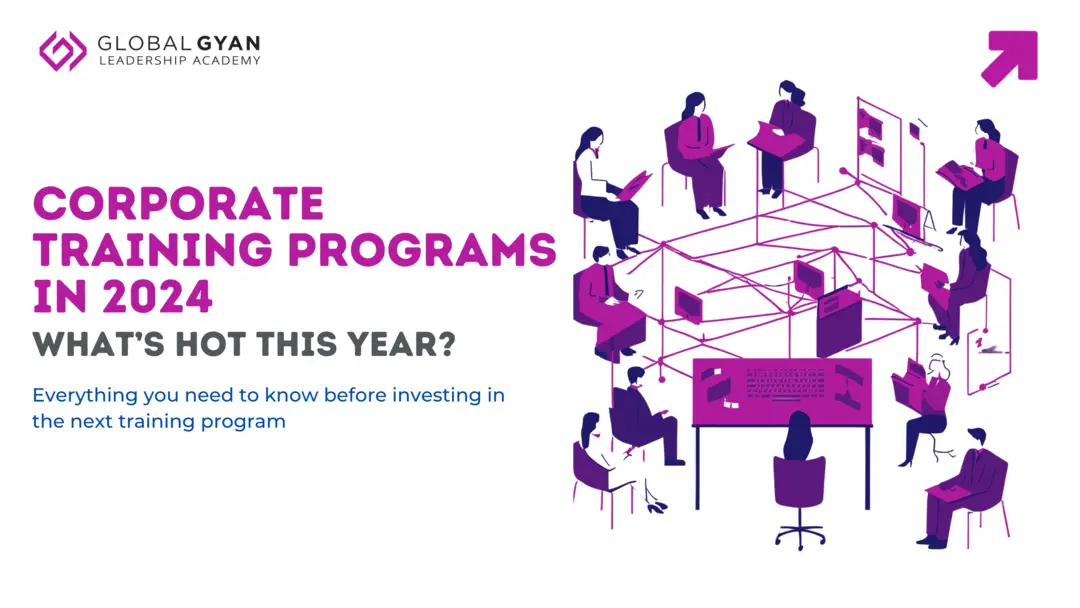
Corporate training just got cooler in 2025!
We know, we’re late to the party, but while we were away delivering incredible corporate training programs, we’re glad to report that corporate training got a nice little facelift.
Today, businesses have got more competitive and job profiles have become a lot more fluid, with new positions being introduced across the board that require employees to possess niche skills. Even the broader, more generic roles like sales, require you to be more ‘holistically developed’, so that you can perhaps weigh in on marketing campaigns, or collaborate with researchers to draw insights for new strategies, or grow as a master strategist, among other things. Long story short, there is no dearth for the directions your career can take, despite your designation shoehorning you into one.
But here’s the catch: taking on these numerous responsibilities across multiple domains can be challenging. Unlike the years gone by, on-the-job training and upskilling have become a necessity rather than an luxury. And training programs have become the need of the hour, whether you like to admit it or not. Investing in the right one can unearth a host of benefits for you. But before you make a choice, let’s look at how corporate training programs have evolved (and continue to do so) in 2025.
New Entrants in the Corporate Training Sphere
Artificial Intelligence (AI) in Training Programs
Artificial Intelligence (AI) has revolutionised corporate training by making learning more adaptive, personalised and efficient. Traditional training methods often involve a one-size-fits-all approach, but AI allows for a more tailored experience. AI-powered training programs can analyse individual learning styles, pace and performance to curate content that meets the needs of each employee.
One of the key benefits of AI in training is its ability to provide real-time feedback. Through AI-driven platforms, employees can receive immediate insights into their progress, enabling them to adjust their learning strategies on the go. For instance, if you’re struggling with a particular module, the AI system automatically suggests additional resources or alternative explanations to help you grasp the concept better.
AI also enhances training through the use of chatbots and virtual assistants, which can be used to offer on-demand support. These tools can answer questions, guide employees through complex topics and even simulate real-world scenarios for practice. Such on-the-spot assistance ensures that learners are never left in the dark, making the training process more interactive and engaging.
Just-in-Time Training
Just-in-Time (JIT) training, when integrated with AI, is revolutionising how employees access information and develop skills. Traditional training methods often require learners to sit through multiple modules before reaching the content they need, wasting time and reducing engagement & efficiency. But with JIT, you can say goodbye to these hiccups!
With AI-powered JIT training, employees receive relevant learning materials precisely when they need them, whether it’s during a task or in preparation for a specific project. For instance, if an employee is about to perform a task they’re unfamiliar with, JIT training provides immediate access to relevant instructional content. This could be in the form of a quick tutorial, a checklist, or a short video. The goal is to empower employees to solve problems and make decisions on the spot, thereby increasing efficiency and reducing the need for direct supervision.
This efficiency enhances productivity by delivering content in real time, reducing the time spent on irrelevant modules. AI’s ability to predict what training is required based on an employee’s job role, performance data, or upcoming tasks ensures that learning is directly aligned with immediate needs. By combining JIT with AI, organisations can create more flexible, on-demand learning environments that support continuous development. This model empowers employees to solve problems faster, apply knowledge immediately, and reduce the cognitive overload associated with traditional training courses.
JIT training is best delivered on mobile & smartphones or tablets, allowing employees to access learning materials at the tip of their finger (literally), whether they’re in the office or out in the field. This on-demand access ensures that learning is always within reach, making it an invaluable tool for today’s agile workforce.
A 10-minute microlearning course has a completion rate of 83%, compared to 20% to 30% for standard learning and development courses.
– Nikola Roza, Blogger & Internet Marketer
Resource Corner: Never miss another leadership insight. Subscribe to Gyan Cafe today!
Board Games for Problem Solving & Decision Making
Board games are gaining traction as an innovative tool in corporate training, particularly for improving problem-solving and decision-making skills. They often simulate real-world business challenges, which require employees to think critically, collaborate with teammates and make decisions under pressure. These elements mirror the complexities of workplace scenarios, allowing learners to develop leadership, strategy and communication skills in a risk-free environment.
Board games also encourage creative thinking, as participants learn to navigate unpredictable circumstances and adapt their strategies on the go. Beyond skill-building, board games propagate camaraderie and teamwork, instilling a sense of collaboration that translates to better performance in the workplace.
Other benefits of board games in corporate training programs include:
- Reducing training fatigue, which a common challenge in lengthy corporate training programs. The interactive and engaging nature of board games helps break the monotony of traditional training formats, making learning more enjoyable.
- Promoting active learning, as employees must participate fully and think on their feet, which increases the likelihood of them retaining information.
- Providing opportunities for social interaction, encouraging employees to communicate and collaborate with their peers. This helps to strengthen team bonds, improve interpersonal relationships and create a more cohesive working environment.
- Offering a safe space for experimentation. Learners can test different approaches without fear of failure, which in turn engenders creativity and innovation.
Hybrid Learning Models are the New Norm
At GlobalGyan, we’re the champions of blended learning journeys (also known as hybrid learning), as we believe that every learner should enjoy learning, get the most out of it whilst not feeling overwhelmed by their busy schedules. Our learning interventions are designed specifically to meet these needs.
In essence, blended or hybrid learning models integrate virtual learning with in-person training, and have become the preferred approach in corporate training today. This model offers the flexibility of online learning, which allows employees to access content at their own pace, alongside the benefits of in-person sessions, where they can engage in discussions, collaborate with peers and receive immediate feedback from instructors.
The blend of these methods caters to many a learning styles, ensuring that all employees, regardless of their preferences, participate fully in the training process whilst staying engaged. Moreover, hybrid models help organisations scale their training programs efficiently, reaching global teams without the logistical challenges of traditional in-person sessions.
Components of Hybrid Learning
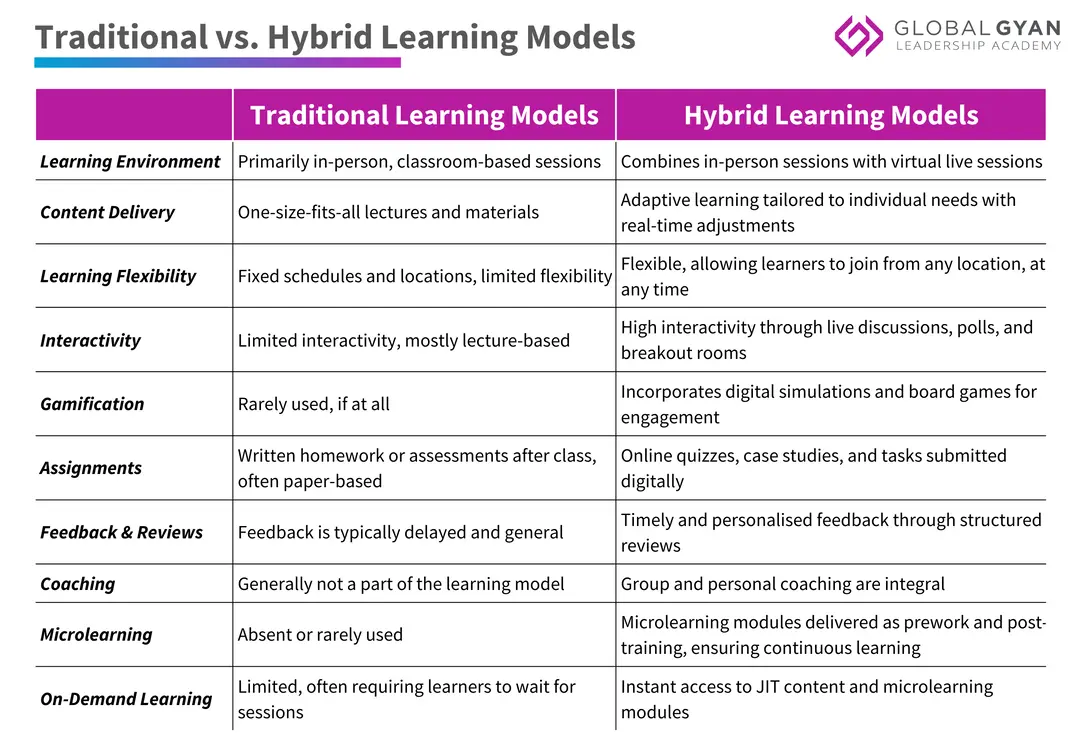
1. Blend of Live & Virtual Sessions
Hybrid learning stipulates having a good blend of live and virtual live sessions to enrich a training program with the strengths of both in-person and online formats. Live sessions, like in-person workshops and classroom learning, allow employees to engage directly with instructors and peers. These face-to-face interactions are crucial for discussions, hands-on practice and real-time feedback that provide a collaborative learning experience.
On the other hand, virtual live sessions which are conducted online (via Zoom, MS Teams, etc.) bring flexibility and accessibility into the mix. Employees can join from anywhere in the world, making it easier for geographically dispersed teams to participate in a common training session. Virtual sessions often incorporate interactive tools like polls, breakout rooms and chat features to maintain engagement and mimic the dynamics of in-person classes.
The blend of these two approaches ensures a balanced learning experience that adequately caters to different learning styles and schedules. This combination makes hybrid learning adaptable to the modern workforce, providing the best of both worlds—personal interaction and digital convenience.
2. Assignments
Assignments in hybrid learning play a crucial role in reinforcing knowledge and allowing employees to apply what they’ve learned. After live or virtual sessions, participants are often asked to complete tasks that challenge them to reflect on or use/apply the newly-acquired concepts. These assignments can range from quizzes, case studies, or problem-solving exercises to written reflections or presentations.
With assignments, learners need to actively engage with the material, thus deepening their understanding of the subject matter and improving retention. In a hybrid model, these tasks can be submitted online, reviewed by instructors and discussed during follow-up sessions. Assignments also help trainers assess learner progress and identify areas where additional support may be needed. Furthermore, they offer an opportunity for self-assessment, as employees can evaluate their own understanding and proficiency before moving on to more complex topics. Overall, assignments create a continuous learning loop, ensuring employees can confidently apply their knowledge in practical, work-related contexts.
3. Group/Individual Projects with Reviews
Individual and group projects are an essential component of hybrid learning as they offer hands-on, real-world experience. These projects encourage learners to apply their newly acquired skills to practical challenges, either independently or in collaboration with peers. With individual projects, employees can shine the spotlight on their own understanding of the course content, while group projects help build soft skills like teamwork, communication and collaborative problem-solving.
Hybrid learning models typically include structured reviews, where projects are evaluated by trainers, peers or managers. These reviews provide valuable feedback that focus on the project strengths and opportunities for improvement. The review process also creates a sense of accountability and encourages continuous learning, as employees refine their work based on constructive critique. In the corporate context, these projects often reflect real-world scenarios (primarily pertaining to their business), which allows employees to practice decision-making, leadership and strategic thinking in a risk-free environment.
4. Gamification: Digital Simulations & Board Games
Gamification adds an element of fun and competition to hybrid learning models whilst significantly boosting engagement and motivation among employees. By introducing game-like elements—such as points, badges, leaderboards and challenges—into both online and in-person training sessions, organisations can make learning more interactive and enjoyable for their employees.
Digital games and simulations offer employees a safe environment to practice skills and make decisions without real-world consequences. For instance, business simulations can allow learners to manage virtual companies, test their problem-solving abilities, or experiment with leadership strategies. These activities help employees sharpen their decision-making and critical thinking in a risk-free setting. Meanwhile, traditional board games can used to promote soft skills like teamwork, strategy and collaboration. These games enhance learning by engaging participants in friendly competition, fostering communication and cooperation among team members.
In essence, gamification can be used to explain concepts in a fun way, test one’s understanding of concepts and track progress across different training modules. You can dial it up a notch by incentivising these; for example, employees can earn rewards for completing online tasks that they can then bring into in-person sessions. This approach encourages continuous learning and instils a sense of achievement.
Resource Corner: Our board game simulations turn tedious corporate training programs
into competitive carnivals!
5. Microlearning as Pre- & Post-Training Support
Microlearning is pivotal to hybrid learning models, providing short, bite-sized, self-paced learning content online. They are often delivered as prework before live or virtual sessions, preparing learners with foundational knowledge so they can actively participate in discussions. Prework may include short videos, articles, or quizzes that introduce key concepts in a quick, digestible format.
After the main training, microlearning continues to play a role through post-training or continuous learning modules. These follow-up lessons help reinforce what was taught and offer employees ongoing opportunities to review and apply their knowledge. The brevity of microlearning modules makes them ideal for revising key concepts at your own pace in a way that ensures retention over a long period of time.
In the hybrid model, microlearning acts as a bridge between online and in-person learning, ensuring that employees remain engaged, learn continuously and quickly apply what they’ve learned in real-world situations.
Invest in Personalised Training
It’s 2025, which means, time to cater to individual employees in different ways, so as to maximise learning and, in turn, yield returns. Here’s what it all comes down to:
Coaching: Group & Personalized Coaching
Coaching, both in groups and one-on-one, plays a critical role in elevating personalised training interventions by providing employees with customised guidance for specific needs. Group coaching encourages peer-to-peer learning and collaboration by allowing employees to share experiences, insights and challenges with others in similar roles. For example, in a group coaching session for finance teams, participants might share strategies for interpreting P&L statements, create fool proof budgets, etc., with the coach facilitating and offering expert advice.
Whereas, in personalised coaching, the focuses lies on individual development. Employees receive one-on-one guidance from a coach who helps them address unique challenges, set (and track) personalised goals and develop specific skills. For instance, a new manager might work with a personal coach to improve leadership capabilities, learning how to delegate effectively or manage team dynamics. This targeted support ensures that employees receive actionable feedback, accelerating their professional growth and improving their confidence in their roles.
Adaptive Learning Technologies
Adaptive learning technologies are at the forefront of personalised training. They offer customised learning experiences that adjust to each employee’s needs. Adaptive learning harnesses the power of data analytics to assess a learner’s progress in real time, adapting the content, pace and difficulty based on their performance.
For instance, if you’re struggling to understand a particular concept, the system provides additional resources or alternative explanations to help you understand those concepts better. Conversely, if you excel in something, the program introduces more advanced material to challenge your knowledge further.
This personalised approach ensures that each employee receives the most relevant training, enhancing overall engagement and retention. Adaptive learning not only makes training more efficient by focusing on areas that need improvement but also empowers employees by giving them control over their learning journey.
Employee-Centric Learning Paths
Employee-centric learning paths put the learner in control, allowing them to choose the content and pace of their training. This approach acknowledges that each employee has unique career goals, strengths and areas for development. By offering a range of learning options—such as self-paced courses, workshops and on-the-job training—organisations empower employees to take ownership of their professional growth.
Employees can select the modules that are most relevant to their current roles or future aspirations; this way, they can ensure that their training is both meaningful and motivating. This flexibility not only improves engagement but also ascertains that the training is directly applicable to the employee’s job, leading to better performance and job satisfaction. Employee-centric learning paths propagate a culture of continuous learning and development as they align individual growth with organisational goals.
Corporate training in 2024 has become the need of the hour—for employees across the board. However, it has now evolved into It is all about integrating technology & personalisation, with a bit of hybrid learning sprinkled in for good measure. We at GlobalGyan are passionate about delivering top-class leadership & management training programs for corporate professionals. If you’re looking for something specific—or need guidance on selecting the best fit for your requirements—get in touch with our representative Kajal Motwani (kajal@globalgyan.in) today.
FAQs:
1. What is the future of corporate training in 2025 & beyond?
- AI, microlearning and hybrid learning will dominate corporate training in 2025.
2. Why do we need corporate training in 2025?
- To upskill employees, adapt to changing trends and enhance business competitiveness.
3. What is the cost of corporate training?
- We offer a wide range of corporate training courses. Please reach out to our representative Kajal Motwani (kajal@globalgyan.in) for a personal consult.

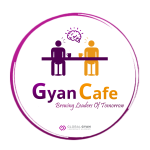



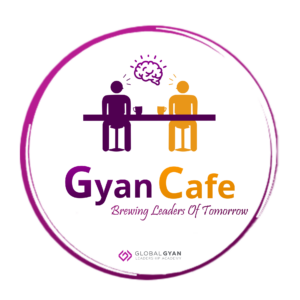
Responses